wheel OLDSMOBILE SILHOUETTE 1994 Owners Manual
[x] Cancel search | Manufacturer: OLDSMOBILE, Model Year: 1994, Model line: SILHOUETTE, Model: OLDSMOBILE SILHOUETTE 1994Pages: 276, PDF Size: 15.82 MB
Page 6 of 276
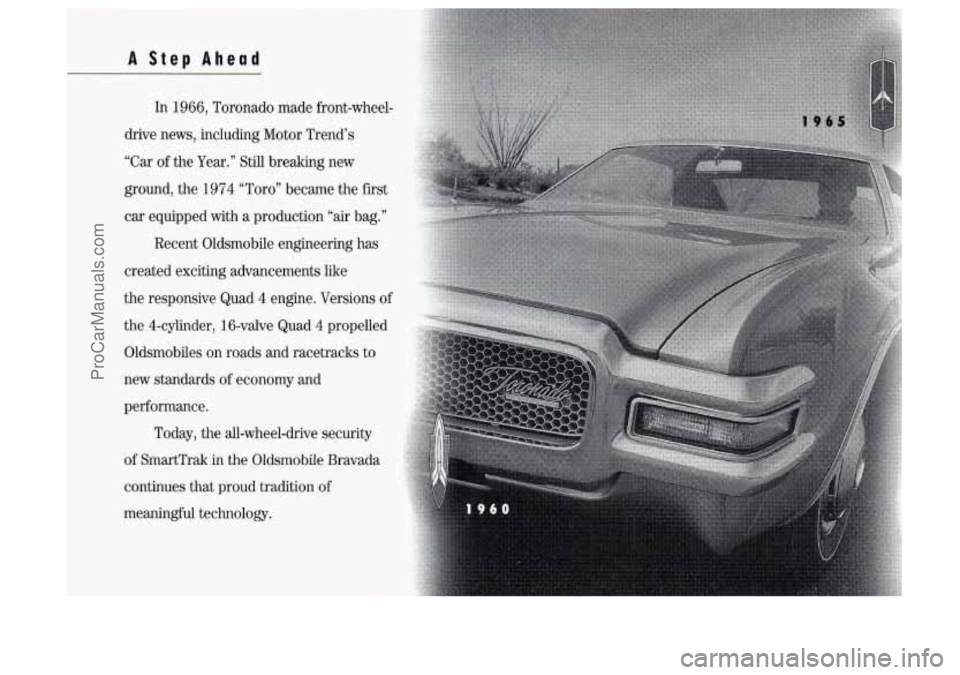
A Step Ahead
!
I
In 1966, Toronado made front-wheel-
drive news, including Motor Trend’s
“Car of the Year.’’ Still breaking new
ground, the 1974
“Toro” became the first
car equipped with
a production “air bag.”
Recent Oldsmobile engineerhg
has
created exciting advancements like
the responsive Quad
4 engine. Versions of
the 4-cylinder, 16-valve Quad 4 propelled
Oldsmobiles on roads and racetracks to
new standards
of economy and
performance. Today, the all-wheel-drive security
of SmartTrak in the Oldsmobile Bravada
continues that proud tradition
of
rneaningfid technology.
ProCarManuals.com
Page 22 of 276
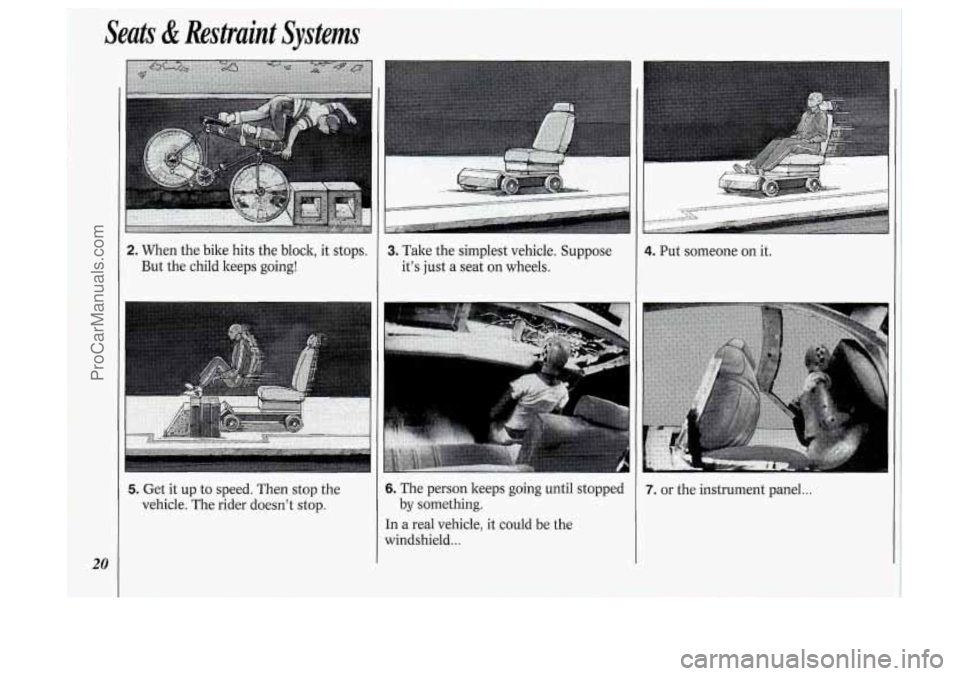
Seats & Restraint Systems
4. Put someone on it. 2. When the bike hits the block, it stops.
But the child keeps going! 3. Take the simplest vehicle. Suppose
it's just a seat on wheels.
I
5. Get it up to speed. Then stop the
vehicle. The rider doesn't stop. i: 6. The person keeps
going until stopped
In a real vehicle, it could be the
windshield..
.
by something. nstrurnent panel
...
20
ProCarManuals.com
Page 30 of 276
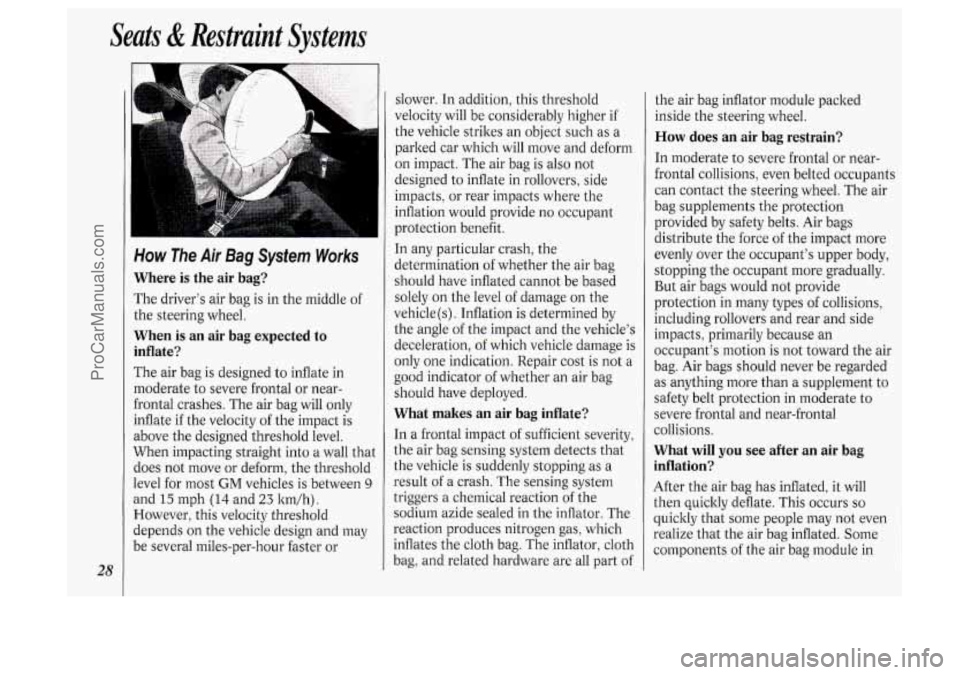
Seats & Restraint Systems
28
How The Air Bag System Works
Where is the air bag?
The driver’s air bag is in the middle of
the steering wheel.
When is an air bag expected to
inflate?
The air bag is designed to inflate in
moderate to severe frontal or near-
frontal crashes. The air bag will only
inflate
if the velocity of the impact is
above the designed threshold level.
When impacting straight into a wall that
does not move or deform, the threshold
level for most
GM vehicles is between 9
and 15 mph (14 and 23 ltm/h).
However, this velocity threshold
depends on the vehicle design and may
be several miles-per-hour faster or slower.
In addition, this threshold
velocity will be considerably higher
if
the vehicle strikes an object such as a
parked car which will move and deform
on impact. The air bag is also not
designed to inflate in rollovers, side
impacts, or rear impacts where the
inflation would provide no occupant
protection benefit.
In any particular crash, the
determination of whether the air bag
should have inflated cannot be based
solely on the level of damage on the
vehicle(s)
. Inflation is determined by
the angle
of the impact and the vehicle’s
deceleration, of which vehicle damage is
only one indication. Repair cost is not a
good indicator of whether an air bag
should have deployed.
What makes an air bag inflate?
In a frontal impact of sufficient severity,
the air bag sensing system detects that
the vehicle is suddenly stopping as a
result of a crash. The sensing system
triggers a chemical reaction of the
sodium azide sealed in the inflator. The
reaction produces nitrogen gas, which inflates the cloth bag. The inflator, cloth
bag, and related hardware are all part of the
air bag inflator module packed
inside the steering wheel.
How does an air bag restrain?
In moderate to severe frontal or near-
frontal collisions, even belted occupants
can contact the steering wheel. The air
bag supplements the protection
provided by safety belts. Air bags
distribute the force of the impact more
evenly over the occupant’s upper body,
stopping the occupant more gradually.
But air bags would not provide
protection in many types of collisions,
including rollovers and rear and side
impacts, primarily because an
occupant’s motion is not toward the air
bag. Air bags should never be regarded
as anything more than a supplement to
safety belt protection in moderate to
severe frontal and near-frontal
collisions.
What will you see after an air bag
inflation?
After the air bag has inflated, it will
then quickly deflate. This occurs
so
quicldy that some people may not even
realize that the air bag inflated. Some
components of the air bag module in
ProCarManuals.com
Page 31 of 276
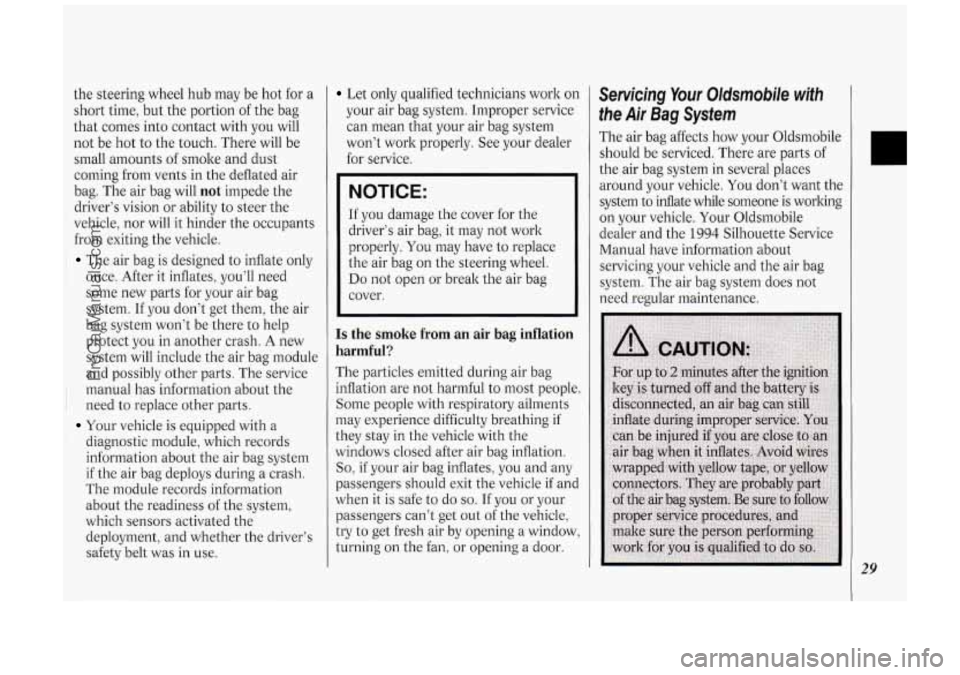
the steering wheel hub may be hot for a
short time, but the portion of the bag
that comes into contact with you will
not be hot to the touch. There will be
small amounts of smoke and dust
coming from vents in the deflated air
bag. The air bag will
not impede the
driver’s vision or ability to steer the
vehicle, nor will it hinder the occupants
from exiting the vehicle.
The air bag is designed to inflate only
once. After
it inflates, you’ll need
some new parts for your air bag
system. If you don‘t get them, the air
bag system won’t be there to help
protect you in another crash. A new
system will include the air bag module
and possibly other parts. The service
manual has information about the
i need to replace other parts.
Your vehicle is equipped with a
diagnostic module, which records information about the air bag system
if the air bag deploys during a crash.
The module records information
about the readiness of the system,
which sensors activated the
deployment, and whether the driver’s
safety belt was in use.
Let only qualified technicians work on
your air bag system. Improper service
can mean that your air bag system
won’t work properly. See your dealer
for service.
NOTICE:
If you damage the cover for the
driver’s air bag, it may not work
properly. You may have to replace
the air bag on the steering wheel.
Do not open or break the air bag
cover.
Is the smoke from an air bag inflation
harmful?
The particles emitted during air bag
inflation are not harmful to most people.
Some people with respiratory ailments
may experience difficulty breathing
if
they stay in the vehicle with the
windows closed after air bag inflation.
So, if your air bag inflates, you and any
passengers should exit the vehicle if and
when it is safe to do
so. If you or your
passengers can’t get out of the vehicle,
try to get fresh air by opening a window,
turning on the fan, or opening a door.
Servicing Your Oldsmobile with
the Air Bag System
The air bag affects how your Oldsmobile
should be serviced. There are parts of
the air bag system in several places
around your vehicle.
You don’t want the
system to inflate while someone is working
on your vehicle. Your Oldsmobile
dealer and the
1994 Silhouette Service
Manual have information about
servicing your vehicle and the air bag
system. The air bag system does not
need regular maintenance.
29
ProCarManuals.com
Page 45 of 276
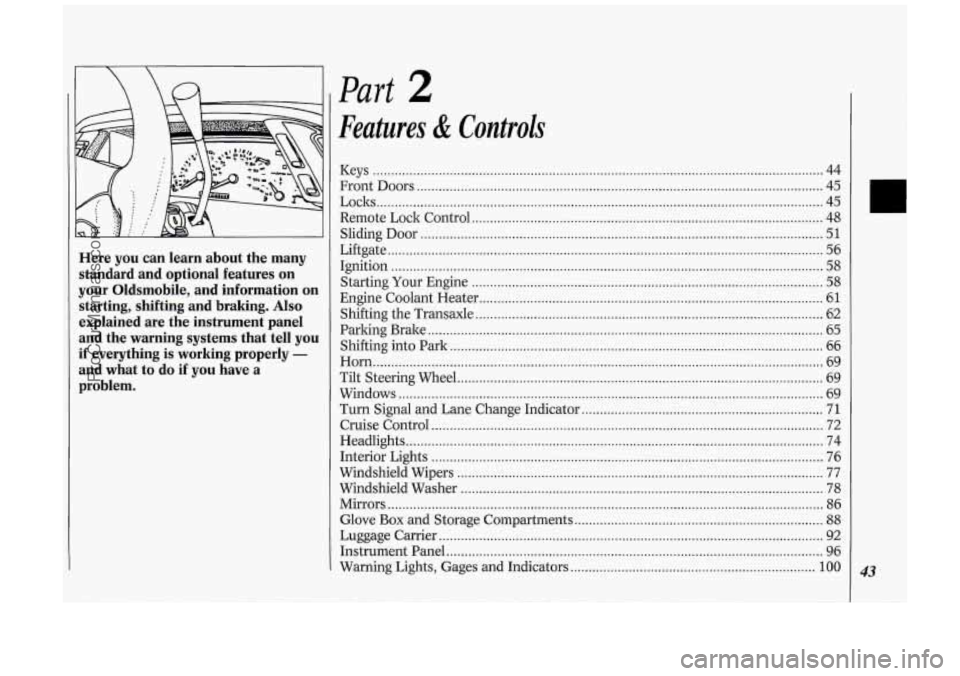
Here you can learn about the many standard and optional features on
your Oldsmobile. and information on
starting. shifting and braking
. Also
explained are the instrument panel
and the warning systems that tell you
if everything is working properly -
and what to do if you have a
problem
.
Part 2
Features & Controls
Keys ........................................................................\
................................................... 44
Front Doors
........................................................................\
....................................... 45
Remote Lock Control
........................................................................\
........................ 48
Liftgate
........................................................................\
............................................... 56
Starting Your Engine
........................................................................\
........................ 58
Engine Coolant Heater ........................................................................\
...................... 61
Loclts
........................................................................\
.................................................. 45
Sliding Door
........................................................................\
...................................... 51
Ignition ........................................................................\
.............................................. 58
Shifting the Transaxle
........................................................................\
....................... 62
Parking Brake
........................................................................\
.................................... 65
Shifting into Park
........................................................................\
.............................. 66
Horn ........................................................................\
................................................... 69
Tilt Steering Wheel
........................................................................\
............................ 69
Windows
........................................................................\
............................................ 69
Turn Signal and Lane Change Indicator
.................................................................. 71
Cruise Control ........................................................................\
................................... 72
Headlights
........................................................................\
.......................................... 74
Interior Lights
........................................................................\
................................... 76
Windshield Wipers
........................................................................\
............................ 77
Windshield Washer
........................................................................\
........................... 78
Mirrors
........................................................................\
............................................... 86
Glove
Box and Storage Compartments .................................................................... 88
Luggage Carrier ........................................................................\
................................. 92
Instrument Panel
........................................................................\
............................... 96
Warning Lights, Gages and Indicators
................................................................... 100 43
ProCarManuals.com
Page 52 of 276

Features & Controls
50
Battery Replacement
Under normal use, the batteries in your
key chain transmitter should last about
two years.
You can tell the batteries are weak if the
transmitter won‘t work at the normal
range in any location.
If you have to get
close to your vehicle before the
transmitter works, it’s probably time
to
change the batteries.
To Replace Batteries in the Remote
Lock Control:
1. Insert a coin into the slot in the back
of the transmitter, and turn
counterclockwise to open the cover.
2. Remove the cover.
3. Remove and replace the two 3-volt
batteries
(DL 20 16).
4. Reassemble the transmitter.
5. Check the transmitter operation.
I Illuminated Entry System
(OPTION)
This option comes with the optional
remote lock control system.
When you open the driver’s door, by
itself or in combination with any
passenger door or the liftgate, the
interior lights will come on and then
gradually dim to off
10 seconds after the
kt door is closed.
(If the driver’s door
has not been opened, the interior lights
will immediately dim to off.)
When you press
a on your remote
transmitter, the lights inside your
vehicle will go on, then gradually dim to
off after about
40 seconds, unless a
door or the liftgate is opened.
When you turn on the ignition, the
interior lights will immediately dim to
off. Vehicle
theft is big business, especially
in some cities. Although your
Oldsmobile has a number of theft
deterrent features, we know that
nothing we put
on it can make it
impossible to steal. However, there are
ways you can help.
Key in the Ignition
If you walk away from your vehicle with
the keys inside, it’s an easy target for
joy riders or professional thieves
- so
don’t do it.
When you park your Oldsmobile and
open the driver’s door, you’ll hear a
chime reminding you to remove your
key from the ignition and take it with
you. Always do this. Your steering
wheel will be locked, and
so will your
ignition and transaxle. And remember
to lock the doors.
ProCarManuals.com
Page 60 of 276

Features & Con&oli
58
U
I Ignition Switch
With the ignition key in the ignition
switch, you can turn the switch to five
positions:
Accessory: An “on” position in which
you can operate your electrical power
accessories. Press in the ignition switch
as you turn the top
of it toward you.
Lock: The only position in which you
can remove the ltey. This loclts your
steering wheel, ignition and transaxle.
Off Unlocks the steering wheel,
ignition, and transaxle, but does not
send electrical power to any accessories
Use this position
if your vehicle must be
pushed or towed, but never try to push-
start your vehicle.
A warning chime will
sound
if you open the driver’s door the
ignition.
Run: An “on” position to which the
switch returns after you start your
engine and release the switch. The
switch stays in the
Run position when
the engine is running. But even when
the engine is not running, you can use
Run to operate your electrical power
accessories, and to display some
instrument panel warning lights.
Start: Starts the engine. When the
engine starts, release the ltey. The
ignition switch will return to
Run for
normal driving.
Note that even if the engine is not
running, the positions
Accessory and
Run are “on” positions that allow you
to operate your electrical accessories,
such as the radio.
NOTICE:
If your key seems stuck in Lock
and you can’t turn it, be sure it is
all the way in. If it is, then turn the
steering wheel left and right while
you turn the key hard. But turn the
key only with your hand. Using a
tool
to force it could break the key
or the ignition switch. If none of
this works, then your vehicle needs
service.
I Starting Your Engine
Engines start differently. The 8th digit
of your Vehicle Identification Number
(VIN) shows the code letter or number
for your engine.
You will find the VIN
at the top left of your instrument panel.
(See
Vehicle Identification Number in
the
Index.) Follow the proper steps to
start the engine.
Move your shift lever
to P (Park) or N
(Neutral). Your engine won’t start in
any other position
- that’s a safety
feature.
To restart when you’re already
moving, use
N (Neutral) only.
ProCarManuals.com
Page 64 of 276
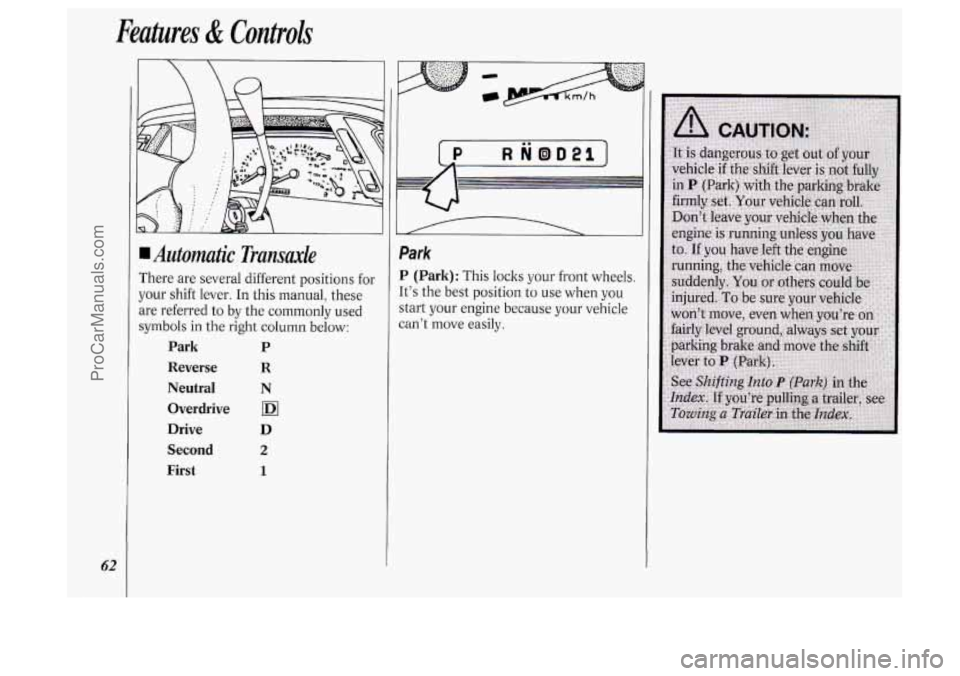
Features & Controls
62
I
Automatic Transaxle
There are several different positions for
your shift lever.
In this manual, these
are referred
to by the commonly used
symbols
in the right column below:
Park P
Reverse
R
Neutral N
Overdrive ID(
Drive D
Second 2
First 1
,-
RNODel]
Park
P (Park): This loclts your front wheels.
It’s the best position
to use when you
start your engine because your vehicle
can’t move easily.
ProCarManuals.com
Page 65 of 276
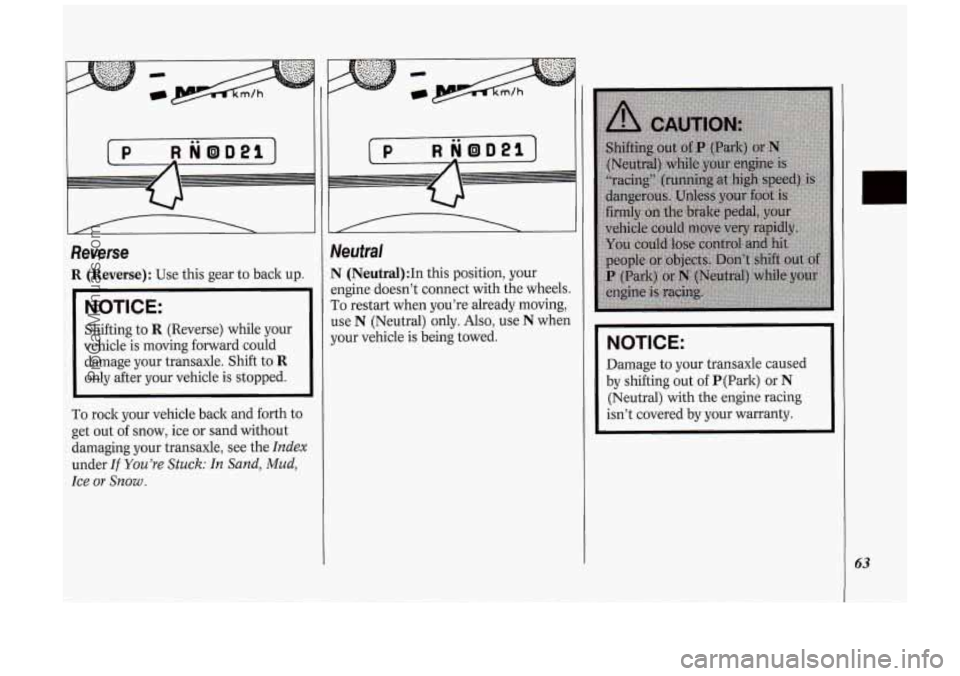
Reverse
R (Reverse): Use this gear to back up.
NOTICE:
Shifting to R (Reverse) while your
vehicle is moving forward could
damage your transaxle. Shift to
R
only after your vehicle is stopped.
To rock your vehicle back and forth to
get out of snow, ice or sand without
damaging your transaxle, see the
Index
under If You’re Stuck: In Sand, Mud,
Ice
or Snow .
Neutral
N (Neutral):In this position, your
engine doesn’t connect with the wheels.
To restart when you’re already moving,
use N (Neutral) only.
Also, use N when
your vehicle is being towed.
NOTICE:
Damage to your transaxle caused
by shifting out
of P(Park) or N
(Neutral) with the engine racing
isn’t covered by your warranty.
63
ProCarManuals.com
Page 67 of 276
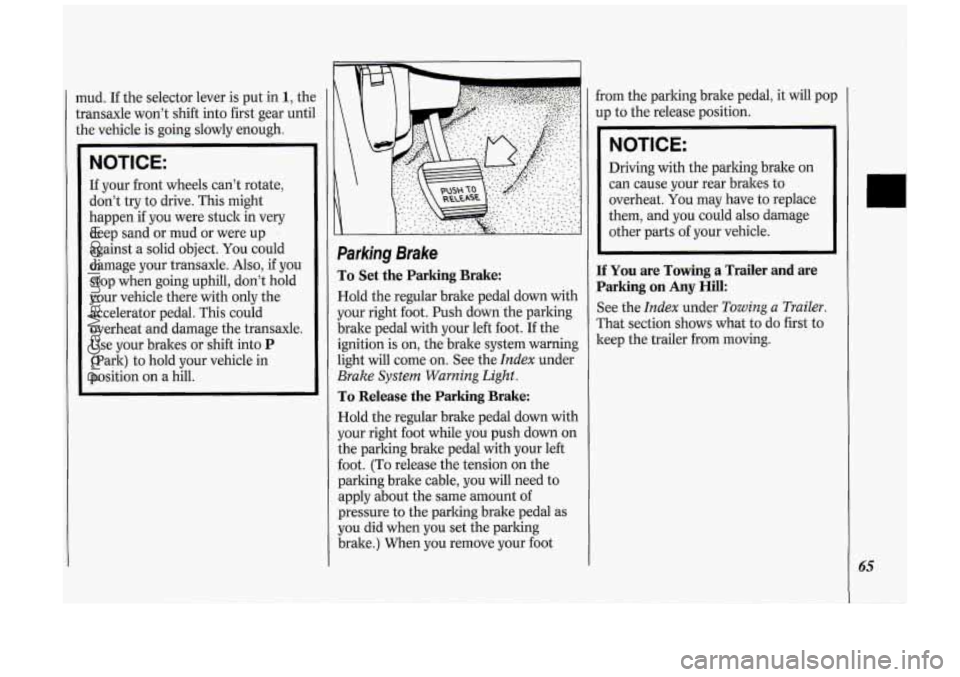
ud. If the selector lever is put in 1, thc
ansaxle won’t shift into first gear unti
le vehicle is going slowly enough.
NOTICE:
If your front wheels can’t rotate,
don’t try to drive.
This might
happen
if you were stuck in very
deep sand or mud or were up
against a solid object.
You could
damage your transaxle. Also,
if you
stop when going uphill, don’t hold
your vehicle there with only the
accelerator pedal. This could
overheat and damage the transaxle.
Use your brakes or shift into
P
(Park) to hold your vehicle in
position on a hill.
Parking Brake
To Set the Parking Brake:
Hold the regular brake pedal down with
your right foot. Push down the parking
brake pedal with your left foot. If the
ignition is on, the brake system warning
light will come
on. See the Index under
Brake System Warning Light.
To Release the Parking Brake:
Hold the regular brake pedal down with
your right foot while you push down on
the parking brake pedal with your left
foot. (To release the tension on the
parking brake cable, you will need to
apply about the same amount of
pressure to the parking brake pedal as
you did when you set the parking
brake.) When you remove your foot from
the parking brake pedal, it will pop
up to the release position.
NOTICE:
Driving with the parking brake on
can cause your rear brakes to
overheat.
You may have to replace
them, and you could also damage
other parts of your vehicle.
If You are Towing a Trailer and are
Parking on
Any Hill:
See the Index under Towing a Trailer.
That section shows what to do first to
keep the trailer from moving.
ProCarManuals.com